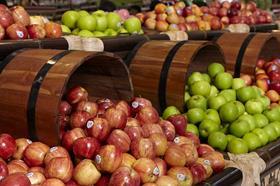
The Sustainability Fruits and Vegetables Initiative (Sifav) claims it is on course to meet its target of sourcing 100 per cent sustainably-grown fruits and vegetables by 2020. Last summer the group, which includes Ahold, ICA, Jumbo, Lidl, Coop and C1000, announced that it was on track with its goal of 30 per cent sustainability in 2014. The target for next year in 50 per cent.
“Sustainability is important, so that we can keep producing in the long term. This means the inclusion of smallholder farmers into the supply chain,” said Tony Bruggink, programme director of the IDH Fruits and vegetables programme at last week’s IGD’s Supply Chain Summit held in London last week.
Bruggink said retailers recognised the important role they had in increasing sustainability in the supply chain, both by scaling up existing initiatives and developing new producer support projects. “Their commitment shows the importance of mainstreaming sustainability in the sector,” he said.
According to Michiel van Zanten, sourcing director at Ahold, customers increasingly demand sustainability, as more and more people are aware of it. “Many non-profit organisations are challenging us, so it has become part of our core business. It is a balancing act to be innovative, have best quality and affordable prices. Sustainability is part of that package, and before we joined Sifav we recognised this,” he said.
So far in 2014, nine additional companies have joined the initiative, resulting in an increased number of participants in the covenant. European traders and retailers annually import approximately 13.4m tonnes of fruits and vegetables from Central and South America, Africa and Asia, with a total value exceeding €10bn.
“As a market leader, we need to set ourselves high goals: 30 per cent is not enough, as we believe that sustainability is a ladder,” Van Zanten said. “You take it step by step, and it has many challenges that keep moving, so we need to keep fine-tuning our ambitions. We would like to strive for 100 per cent sustainability; it is in our DNA.”



